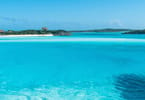According to the Ogasawaramura Tourist Association, 14,507 middle-aged and elderly tourists visited the islands in fiscal 2011 by the regular liner, the Ogasawara Maru. This was up 30 percent from the previous fiscal year.
The Ogasawara Islands in Japan have welcomed an increase in middle-aged and elderly tourists since the islands were registered as a World Natural Heritage site in 2011, but authorities have also had to deal with an increase in injuries and other medical problems as a result.
Mainly young people used to visit the islands in summer, but people in their 40s and older have been visiting the islands throughout the year since the registration. The tourism industry has been boosted by such off-season vistiors, but the increase in tourists is causing unexpected problems, and the local government is struggling to cope with them.
People in the local tourism industry are delighted by the increase. A person who runs a minshuku inn on the island said, “Our yearly sales increased by 50 percent.”
Another person in the marine leisure industry said off-season sales at his business have nearly doubled.
However, a growing number of middle-aged and elderly visitors are becoming injured or sick on the islands. According to a local travel agency and other sources, various problems have occurred, such as an elderly man who broke his leg by stumbling and falling during a trekking tour.
Another elderly man who participated in a dolphin observation tour developed severe seasickness. As the major tourist activities on the islands are diving and trekking, which require physical strength, middle-aged and elderly people are apt to complain of physical problems, saying the tours are too hard for them.
A 60-year-old man from Ichikawa, Chiba Prefecture, developed seasickness on the Ogawawara Maru liner after it left Ogasawara’s Chichijima island for Tokyo Bay in October. It takes 25 hours for the ship to reach Tokyo from Chichijima.
The man, who looked exhausted, said: “This is the first time I’ve taken such a long cruise. I climbed a mountain on the island, but it was tough because the trail was slippery.”
Two 59-year-old women who participated in a boat tour to swim with dolphins off Chichijima island said nervously on the constantly wavering boat that they worried about drowning. While the young participants in the tour jumped into the ocean one after another, the two women remained on the boat.
There have been moves to create tourism catering to middle-aged and elderly tourists. Mulberry, a tour company that carries out nature observation tours on Chichijima island, will take tourists to scenic spots by car. Ogasawara Diving Center focuses on courses that enter the sea on foot from a sandy beach, without using a boat.
WHAT TO TAKE AWAY FROM THIS ARTICLE:
- The Ogasawara Islands in Japan have welcomed an increase in middle-aged and elderly tourists since the islands were registered as a World Natural Heritage site in 2011, but authorities have also had to deal with an increase in injuries and other medical problems as a result.
- Mainly young people used to visit the islands in summer, but people in their 40s and older have been visiting the islands throughout the year since the registration.
- The tourism industry has been boosted by such off-season vistiors, but the increase in tourists is causing unexpected problems, and the local government is struggling to cope with them.






















